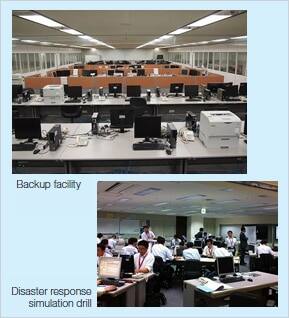A BCP sets forth an organization’s response to an assumed large-scale disaster, thereby facilitating decision-making during the chaotic conditions following a disaster to support orderly operations. The ANA Group’s primary operations are concentrated in the Tokyo area, which means an earthquake with its epicenter there could cause extensive damage and render the Group unable to fulfill its mission as a public transportation provider. The Group has therefore created and periodically reviews a comprehensive manual that assumes the occurrence of large-scale disasters such as an earthquake with its epicenter in the Tokyo area.
The ANA Group has formulated a BCP assuming a major disaster or other critical event in the Tokyo area and constructed backup facilities in the ANA Business Center Building for disaster response should the Group be unable to use its offices in the Haneda area or the Shiodome area, where the head office is located. These disaster-response backup facilities began operating in April 2006. They enable each department to continue operating even if a disaster strikes the head office, and feature computer, radio and other equipment that enable aircraft operation should the Operations Management Center at Haneda Airport become unusable. Moreover, food and daily supplies for three days are stored for business continuity staff. The Group also stores emergency food and daily supplies for business continuity in the Narita, Chubu and Kansai/Itami areas as well as the Shiodome and Haneda areas.
We have also introduced a Safety Confirmation System to quickly determine the safety of all officers and employees and their families, and periodically conduct safety status registration drills.
We have also introduced a Safety Confirmation System to quickly determine the safety of all officers and employees and their families, and periodically conduct safety status registration drills.
 At the time of the Great East Japan Earthquake, prompt decision-making supported by our crisis response manuals allowed us to quickly resume almost all regular flights. While ground transportation remained paralyzed, we operated special relief flights to the Tohoku area while also continuing transport of passengers and relief supplies to affected areas on regular flights.
At the time of the Great East Japan Earthquake, prompt decision-making supported by our crisis response manuals allowed us to quickly resume almost all regular flights. While ground transportation remained paralyzed, we operated special relief flights to the Tohoku area while also continuing transport of passengers and relief supplies to affected areas on regular flights.The ANA Group recognizes that, as a part of the public transport infrastructure, we are strongly expected to continue regular air transport even during emergencies, and to support the transport of relief supplies and other items to affected areas. For that reason, we have readied and regularly review comprehensive mauals for hypothetical large-scale disasters.
In the fiscal year ended March 2012, our actions included a thorough review of our advance preparations, strengthening of our facilities management, and expansion of communications methods. These initiatives were all based on our experience in the Great East Japan Earthquake. Amid strong concerns over the potential occurrence of an earthquake with its epicenter in the Tokyo area and a chain of earthquakes from the Tokai to Nankai regions, we will push ahead with unceasing effort to secure safe air service and continued operation under any conditions through regular drills and other measures.





















